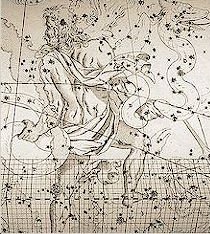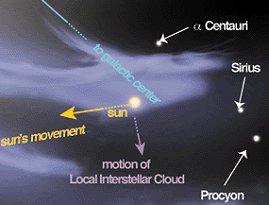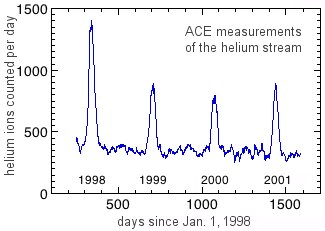A Breeze from the Stars (Science@NASA)
NASA spacecraft are monitoring an interstellar wind coming from the constellation Ophiuchus.
A Breeze from the Stars ―星々を渡る風 ―
NASAの衛星は今、へび使い座から吹いてくる星間風を観測しています。

December 17, 2004: Every year in early December, something happens that can throw your horoscope out of whack. The sun enters Ophiuchus, the little-known 13th house of the zodiac.
2004年12月17日:毎年12月の初めになると、あなたは星占いの庇護の外へと投げだされてしまいます。この頃、太陽は星占いではほとんど知られていない13番目の宮、「へび使い座」にいるんです。
You've probably heard of Capricorn, Aquarius, Pisces, Aries, Taurus, Gemini, Cancer, Leo, Virgo, Libra, Scorpio and Sagittarius. The sun passes through these constellations, one by one, throughout the year. They're the ancient signs of the zodiac.
きっと、山羊座、水瓶座、魚座、雄羊座、雄牛座、双子座、蟹座、獅子座、乙女座、天秤座、蠍座、射手座などはあなたも聞いたことがあるでしょう。太陽は何千年もの間、順々にこれらの星座をめぐってきました。でも、これは古代の黄道12宮に基づくものです。
But Ophiuchus?
でも、へび使い座?
Modern astronomers don't divide the sky the same way ancient astronomers did. According to modern star maps, the sun cuts through a 13th constellation, Ophiuchus the Serpent Bearer, between Nov. 30th and Dec. 17th. Astrologically speaking, if you were born between those dates you're no longer a Sagittarian, you're an Ophiuchi! But that's another story....
現代の天文学者たちは、古代の人々と同じように夜空を区切っていません。今の星図によれば、太陽は13の星座を通り過ぎるます。11月30日から12月17日までの間は、太陽はへび使い座(Ophiuchi)にいるんです。天文学的にいえば、もしこの期間に生まれていたとしたら、あなたは射手座ではなく、へび使い座です。
This story is about what really happens when the sun enters the zodiac's 13th house: An interstellar wind hits our planet.
さて、今日お話したいのは、もう少し別な話。太陽が13番目の宮に入るときに本当に起きること、私たちの星に吹き付ける恒星間の風のお話です。
It's a helium-rich breeze from the stars, flowing into the solar system from the direction of Ophiuchus. The sun's gravity focuses the material into a cone and Earth passes through it during the first weeks of December. We're inside the cone now.
それは、へび使い座の方向から太陽系に向かって吹いている、ヘリウムをたくさん含んだ星々からの風です。太陽の重力は、これらの風に含まれる物質を集め(この領域はちょうど円錐の形をしています)、12月の最初の数週間、地球はこの領域をくぐり抜けます。そう、私たちは今、この領域の真っ只中に居るんです。
"There's no danger to anyone on Earth," says space physicist George Gloeckler of the University of Maryland. "The helium breeze is a thousand billion billion times (1021 times) less dense than Earth's atmosphere. It cannot penetrate to the surface of our planet."
「地球にいる人には、まったく危険はありませんよ」メリーランド大学の宇宙物理学者、ジョージ・グロークラー教授はそう請け合いました。「このヘリウムの風は、地球の大気の何千分の一も、何億分の一も(10の21乗分の一です)薄いんです。私たちの惑星の表面に届くことはありません」
Nevertheless, astronomers are keen to study it.
でも、天文学者たちはこの風を研究したいと心から願っています。
The breeze is a telltale sign of what lies outside the solar system. Interstellar space, the "void" between the stars, is not empty. It's filled with gigantic clouds of gas and dust. These clouds are the birthplace of stars and planets; they're also the debris left behind when stars explode. The solar system is running into one. Astronomers call it the Local Interstellar Cloud. The sun's magnetic field holds much of the cloud at bay, but some of the cloud's gas does penetrate--hence the breeze.
なぜなら、この風は太陽系の外ある物質のヒントを教えてくれるからです。恒星と恒星の間、星々の間の「空虚」な空間は、実際には「空っぽ」ではありません。実は、そこはガスやちりの巨大な雲で満たされているんです。これらの雲は、星が爆発した跡に残されたかけらであり、星や惑星が生まれる場所でもあります。太陽系は今ちょうど、そのひとつの中を通り抜けているところです。天文学者たちはこの雲を「局所恒星間雲(Local Interstellar Cloud)」と呼んでいます。太陽の磁気圏はこの雲の大半を捉えてしまいますが、その一部はそこを突き抜け、風となって吹くのです。
Above: The Sun's gravity deflects the interstellar helium breeze and causes it to pile up downstream from the sun. This concentration is helpful to spacecraft observing the wispy-thin flow. Credit: American Scientist. [
More]
太陽の重力は、恒星間を吹くヘリウムの風をねじ曲げ、太陽から見て風下に当たる部分に集中させます。この物質の集中は希薄で僅かな流れを探査機が捉えるのを助けます。Credit: American Scientist [
詳細]
NASA's ACE (Advanced Composition Explorer) spacecraft, located at the first Lagrange point directly between Earth and the Sun, is perfectly situated to study this breeze. "When Earth moves through the focusing cone (the region of space where the sun's gravity focuses the breeze), so does ACE," explains Gloeckler, who is one of ACE's Lead Co-investigators. "We've been through the cone seven times--once a year since the spacecraft was launched in 1997."
NASAのACE(Advanced Composition Explorer)探査機は、この風を調査するのに最適の場所、地球と太陽のちょうど間の第一ラグランジュ点にいます。「地球が"焦点円錐"(太陽の重力が風をねじ曲げ、一ヵ所に集中させている空間)いる時期だからこそ、ACEが活躍するんです」そう語るグロークラー教授は、ACEの共同開発者の一人でもあります「探査機はこれまで7回この円錐の中を通りました。1997年の打ち上げ以来、ちょうど一年に一回づつです」
ACE's mission is to study the solar wind, the hot breeze from our own star, so the spacecraft is well equipped to study the interstellar breeze, too. An instrument onboard ACE called SWICS detects helium ions in the breeze, measuring their density, temperature and direction of flow. Using these measurements, along with data from other spacecraft (chiefly SOHO and Ulysses), Gloeckler and colleagues have calculated the properties of the Local Interstellar Cloud.
ACE探査機の目的は太陽風―私たちの太陽系にある恒星から吹いてくる熱い風―を観測することです。つまり、探査機には恒星間の風を観測するのに最適の機器が積まれているんです。ACE探査機に積まれたSWICSと呼ばれる機器は、太陽風に含まれるヘリウムイオンの密度と温度、吹いてくる方向を検出します。こういった機器の観測結果や、他の探査機(主にSOHOやUlyssesなど)からのデータから、グロークラー教授と彼の同僚は局所恒星間雲の特性を計算しました。
An artist's concept of the Local Interstellar Cloud. [
More]
局所恒星間雲(Local Interstellar Cloud)のコンセプト図 [
詳細]
It's a hot cloud, the gas temperature is 6000 C, about the same as the temperature of the sun's surface. It's also very wispy, only 0.264 atoms per cubic centimeter. The sun's magnetic field has little trouble deflecting this diaphanous material before it crosses the orbit of Pluto. Only a trickle (0.015 atoms per cubic centimeter) penetrates the inner solar system.
それは、ガスの温度が6000℃にも達する熱い雲です。これは、太陽の表面に匹敵する温度です。また、この雲は非常に希薄で、1平方センチメートルあたり、0.264個の原子しか含んでいません。太陽の磁気はこれらの微かな物質を冥王星の軌道を通過する手前で容易く曲げてしまいます。太陽系内部に入ってくるのは、ほんの僅かな量(1平方センチあたり原子0.015個)だけなのです。
One day the solar system might run into something more massive. There are clouds in the galaxy thousands of times denser than the Local Interstellar Cloud. University of Chicago astronomer Priscilla Frisch has studied what might happen if we plowed into one of those. Writing in the magazine American Scientist she reports, "a cloud with 1,000 atoms per cubic centimeter could compress the sun's magnetic field to within a few AU of the sun. (1 AU or "one astronomical unit" is the distance between the sun and Earth). Planets such as Saturn, Uranus, Neptune and Pluto would be fully exposed to interstellar atoms and molecules. Interstellar gas would overwhelm the solar wind at 1 AU," transforming the space-environment of our planet.
いつの日か、我々の太陽系はもっと大量のガスの中に突入するでしょう。銀河の中には、局所星間雲よりも数千倍も密度の高い雲もあるのです。シカゴ大学の天文学者プリシラ・フリッチは、もし我々がこのような密度の高い雲の中に突っ込んだら何が起きるかについて研究しています。アメリカン・サイエンティスト紙に寄稿したレポートの中で、彼女はこうまとめています。「1立方メートルあたり1000個の分子密度を持った雲は、太陽の磁気圏を数AU(1AUあるいは1天文単位とは太陽と地球の間の距離を指す単位です)に圧縮してしまいます。土星や天王星、海王星、冥王星は恒星間に漂う分子に直接さらされることになるでしょう。星間ガスは太陽風を1AUまで押し縮めることになります」地球を取り巻く環境はすっかり変わってしまうはずです。
The first signs of such a transformation could be the helium breeze thickening or shifting directions, heralding something new to come.
このような変化の兆候は、ヘリウムの風の密度や風向の変化、あるいは新しい物質の検出といった現象に現れます。
ACE has already detected changes. "We see strange gusts, ebbs and flows," says Gloeckler. "We doubt these variations are interstellar." Instead, the sun is probably responsible. The helium breeze must blow through the much denser solar wind, which can push the breeze around. Sunspots also affect the breeze. Ultraviolet radiation shining from sunspots ionizes the breeze and changes the way it appears to instruments like SWICS.
ACE は既に変化を検知しました。「奇妙な突風が吹きました。まるで満ち潮と引き潮のような感じです。私たちは、これが恒星間の変化によるものなのではないかと考えています」同じように、太陽の方も変化します。ヘリウムの風はより密度の高い太陽風の中を吹き抜け、その際に吹き散らされるのです。さらに、太陽黒点も風に影響を与えます。太陽黒点からの紫外線の放射はヘリウムの風をイオン化し、SWICSなどの機器に違う反応をもたらします。
Left: ACE/SWICS measurements of the helium stream. Peaks denote annual passages through the focusing cone.
Click on the image to see the complete 7-year data set.
Left: ヘリウムの風のACE/SWICS による計測値。毎年のピークは、物質が集中する円錐状の領域をを示します。 7年分のデータは
こちらをクリックして下さい。
"What we're doing now," explains Gloeckler, "is learning how solar activity affects the breeze. When we can reliably account for the sun, in detail, then we can use these measurements to diagnose interstellar space."
「私たちが今やっているのは、太陽の活動がその風にどんな影響を与えているかを調べることです。それがちゃんと分かれば、その結果を利用して恒星と恒星の間のことが分かるはずなんです」
What's out there? What's coming? The answer lies in a breeze from the stars of the 13th house.
そこには何があるんでしょうか? あるいは、そこでは何が起きているんでしょうか? 答えは、13番目の宮の星々から吹いてくる風の中です。
Credits & Contacts
Author:
Dr. Tony Phillips
Responsible NASA official:
Ron Koczor
Editor:
Dr. Tony Phillips
Curator:
Bryan Walls
Media Relations:
Steve Roy
The Science Directorate at NASA's Marshall Space Flight Center sponsors the Science@NASA web sites. The mission of Science@NASA is to help the public understand how exciting NASA research is and to help NASA scientists fulfill their outreach responsibilities.




